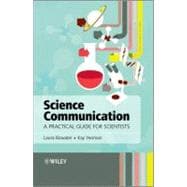
Note: Supplemental materials are not guaranteed with Rental or Used book purchases.
Purchase Benefits
What is included with this book?
Laura Bowater has recently been awarded a Public and Community Engagement Award from CUE (Community University Engagement)?East, the Beacon of Excellence in the Eastern region.
Kay Yeoman's work has been recognized by a nomination for the Royal Society Kohn Award in 2008 and also a Public and Community Engagement Award from CUE East the Beacon of Excellence in the Eastern Region.
About the Contributors, xi
Foreword, xix
Prologue, xxi
Acknowledgements, xxiii
1 A Guide to Science Communication, 1
1.1 Introduction, 1
1.2 The Influence of Science Societies, Charities
and Organisations, 2
1.3 Modern Societies and Organisations, 7
1.4 Science Communication as a Discipline, 7
1.5 Phases of Science Communication, 9
1.6 Recent Initiatives, 18
1.7 A Way Forward, 19
References, 19
2 Scientists Communicating with the Public, 23
2.1 Introduction, 23
2.2 What does ‘Science and Society’ mean for Scientists?
The Changing Environment, 23
2.3 Are Academics Involved in Public Engagement?, 34
2.4 What is the Current Level of Science Communication
by Scientists?, 39
2.5 Concluding Remarks, 43
References, 44
Useful Websites, 45
3 Encouraging Scientists to Communicate with the Public, 46
3.1 Introduction, 46
3.2 Science Communication: the Barriers, 48
3.3 Removing Barriers and Providing Incentives, 52
3.4 Seeking Advice and Support, 63
3.5 Embedding PE in Your Job, 67
3.6 Personal Benefits and Benefits to the Wider Society, 70
References, 72
4 Communication, Learning and Writing, 74
4.1 Communication Theories, 74
4.2 Learning and Learning Theory, 75
4.3 Learning Theory Frameworks, 77
4.4 Constructivism and How it Applies to Science
Communication Events, 77
4.5 Learning Styles, 78
4.6 Model of Family Centred Learning, 83
4.7 Successful Scientific Writing for the Public, 85
4.8 Concluding Remarks, 91
Recommended Additional Reading for Writing
for the Public, 91
References, 91
5 Monitoring and Evaluating your Event or Activity, 93
5.1 Introduction, 93
5.2 Key Stages in Undertaking an Engagement
Project, 94
5.3 Monitoring and Evaluating, 97
5.4 Undertaking Evaluation, 100
5.5 Interviews, 107
5.6 Focus Groups, 108
5.7 Observational Research, 109
5.8 Deciding Which Evaluation Tools to Use for
Your Project, 109
5.9 Analysing the Results, 113
5.10 Reporting the Results, 117
5.11 Assessing Impact, 118
5.12 Ethical Issues Associated with Evaluation
Projects, 119
Other Useful Resources and References, 119
6 Getting Started with Public Science Communication, 121
6.1 Introduction, 121
6.2 Understanding Your Audience, 123
6.3 Taking Your First Steps, 136
6.4 Planning Your Own Event or Activity, 136
6.5 How to Design Hooks for Your Event or Activity, 143
6.6 Designing a Science Communication Activity, 145
6.7 Consider Your Resources – Consumables, Equipment,
Expertise and People (CEEP), 148
6.8 How to Get Your Project Funded, 149
6.9 Top Tips for Successful Marketing, 158
6.10 Health and Safety, 159
6.11 Concluding Remarks, 164
References, 164
7 Direct Public Communication, 166
7.1 Introduction, 166
7.2 Direct Communication Delivering Information, 166
7.3 Information through Conversation, 182
7.4 A Focus on Policymakers, 209
7.5 Concluding Remarks, 225
References, 225
8 Indirect Public Communication, 227
8.1 Introduction, 227
8.2 A Focus on Science and Television, 227
8.3 A Focus on Radio and Science, 232
8.4 A Focus on Newspapers, 235
8.5 A Focus on Science and Writing, 238
8.6 A Focus on Science Advocacy, 244
8.7 A Focus on Citizen Science, 245
8.8 Public Involvement in Health Research, 259
8.9 A Focus on Web 2.0 Tools and Services, 261
8.10 Concluding Remarks, 274
References, 274
9 Getting Started with Science Communication
in Schools, 277
9.1 Introduction, 277
9.2 School Science Education and Scientific
Literacy, 278
9.3 A Skills Shortage in Science, 280
9.4 Attitudes and Knowledge of Young People
about Science, 280
9.5 The Importance of Extra-curricular Science
to Achievement, 284
9.6 Getting Started with Science Communication
in Schools, 285
9.7 Think about your Resources, Consumables
and Equipment, 302
9.8 School Years and Qualifications, 302
9.9 Concluding Remarks, 305
References, 305
Useful Websites, 306
10 Demonstrating Interactions between Scientists
and Schools, 307
10.1 Introduction, 307
10.2 Enhancing the Curriculum within the
School Environment, 308
10.3 Developing Cross-Curricular Activities for
10.4 Enhancing the Curriculum with Activities with a School
Audience but Outside the School Environment, 333
10.5 Influencing Curriculum Change, 337
10.6 Embedding Scientists into Schools, 338
10.7 Training Teachers, 343
10.8 Concluding Remarks, 344
References, 344
Epilogue, 347
Abbreviations and Acronyms, 349
Index, 351
The New copy of this book will include any supplemental materials advertised. Please check the title of the book to determine if it should include any access cards, study guides, lab manuals, CDs, etc.
The Used, Rental and eBook copies of this book are not guaranteed to include any supplemental materials. Typically, only the book itself is included. This is true even if the title states it includes any access cards, study guides, lab manuals, CDs, etc.